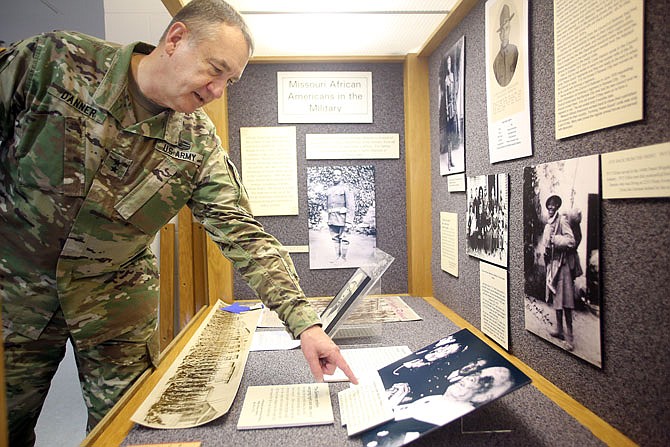Jefferson City baseball enthusiast Toney Jenkins was 21 when he was inducted to the U.S. Army in October 1917 to serve in World War I. Less than a year later, he was killed while serving with the "Harlem Hellfighters."
His photo is part of the Museum of Missouri Military History's Black Heritage Month exhibit on display at the Missouri National Guard headquarters, open to the public.
"As an historian, I hope with the significance of this being the 100th anniversary will cause people to have an interest in this conflict," museum Curator Charles Machon said.
Jenkins served in Company G of the 369th Infantry of 92nd Division, which sustained severe losses in the drive in Meuse-Argonne leading to the capture of the strategic village of Sechault, France.
The first black soldier from Jefferson City to die in World War I, he is the namesake of American Legion Post 231, chartered in 1934 originally as an all-black post.
Machon has been researching Missouri's African-American service members during World War I in recognition of the 100th anniversary this spring of the United States entering that war.
This exhibit will be in the auditorium display case through the end of February. Then it will be available as a traveling exhibit to sites or organizations that request it across the state.
Machon hopes communities will take advantage of the exhibit to educate Missourians about the sacrifices of African Americans during the Great War.
"We want to show they were equal in sacrifice and service," he said.
Contributions of black soldiers, sailors and airmen from Missouri have been difficult to track, Machon noted.
Like the limited details about Jenkins, "I'd like to learn more about him," he said.
Machon, with Lincoln University professor Essex Garner, is researching Missouri African-American military contributions dating back 200 years for a future book on the subject.
Documents and searchable database information at the website missourioverthere.org and at the Missouri State Archive have been helpful, he said.
"For Missouri, these are excellent tools to research World War I," he said.
At the time, the war was called "The War to End All Wars," and Americans believed it was necessary to "make the world safe for Democracy," he said.
The war was the first time chemical weapons, airplanes, tanks and submarines were used in warfare.
All of Missouri's National Guard units were called to duty, joining with Kansas to form the 35th Infantry Division.
But the state had no black units during the era of segregation.
Black Missourians serving during World War I were drafted or enlisted into all-black companies, led by white officers in each of the military branches, Machon said.
Many Missourians became famous from their involvement in World War I, including Gen. John Pershing, President Harry S Truman and Maj. Gen. Enoch Crowder.
Black service members from Missouri equally contributed their services and sacrifice, but records and photos are slim.
They mostly served in "pioneer" or "engineer" units, working behind the lines moving supplies and building roads and bridges.
"Those veterans deserve to be recognized; they did their part," Machon said. "Just because back then, with racism, many of them were put in non-combat jobs, those things needed to be done, too. They still contributed a great deal."
Many black Missourians volunteered, Machon said.
"It was a way to show that even though they were treated this way, 'we're going to do our part,'" he interpreted.
"We can't go back and change history. This exhibit is done to honor their service and sacrifice."
For more information, visit missourioverthere.org and s1.sos.mo.gov/records/archives/archivesdb/soldiers.

